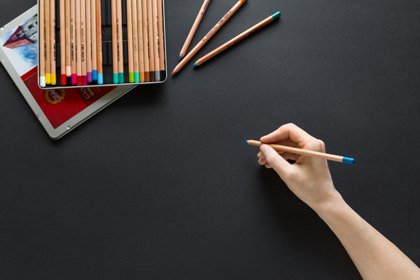
The world is at a standstill. It is as if nothing else matters. I can feel the rhythm of my breath—steady. My mind is engaged, but not entangled in the chaos of life’s expectations. I am in a state of flow, fully immersed in the creative process. My thoughts are nowhere, and yet, they are exactly where they need to be. I am creating art. I am relieving stress, minimizing tension, and improving my mood.
I am a New York State licensed Creative Arts Therapist and currently work in private practice with both children and adults. I have spent years explaining my job to people, as most people believe that Art Therapy is exclusively for children. The reality is that someone who is artistic or appreciates the value of creativity can seek out an Art Therapist instead of a more traditional approach. Art Therapists are trained in counseling, developmental theory, and many forms of therapeutic intervention, in addition to having an understanding of the uses and significance of various art media. Oftentimes issues can be uncovered through processing artwork with a client. Other times, the client’s resolution will come about through creative forms of expression. This process can help someone move forward and address various issues that he or she may be struggling with.
Art as therapy is one of the foundational concepts of Art Therapy. The physical and tactile acts of creating art are therapeutic. Creativity elevates an individual and increases his self-perception. Studies have shown that level of the stress hormone cortisol decreases in individuals while they’re engaging in art.
Another principle of Art Therapy is the concept that our issues manifest in our art. When someone goes for traditional talk therapy, their natural defenses may prevent them from sharing something with the therapist. We are all holding on to baggage deeper than our conscious state. Sometimes, these thoughts are so deeply buried that our defenses will not to let them out, as they may “stir the pot” and cause emotional unease. Other times, our baggage is not as complex, but an important issue may just not be on the forefront of our agenda. These thoughts and ideas have an amazing way of making their way into our art.
Therapy through art is another way to practice Art Therapy. I either give my clients directives or have them choose their art experience for the session. The client engages in and with the art as we talk, sit silently, or play music. Their art serves as a springboard for further discussion and allows deeper exploration into an issue that had been addressed. The art can also serve as a transitional object, comforting the client as she works through complicated, and sometimes painful, feelings.
In addition to being an Art Therapist, I have recently become a certified health coach. Through my experiences, I recognized that there is an important mind-body connection. I know many people who are struggling with nutrition and health problems which are triggered from their unresolved emotional issues. Emotions can play an important part in a person’s eating and influence the overall direction of their “diet”. We live in a culture which stresses diet and exercise, which is wonderful—in the right doses. The problem arises when someone takes it to an extreme or has trouble following through, leading to guilt and shame. I work with my clients to help them identify, understand, and work through these concepts. I am on a mission to help people recognize that the foundation of health and wellness is not about what you eat or how much you exercise. These ideas match up with the principles of what I utilize in my Art Therapy practice, and I use creativity and art as a tool for health coaching as well. My ultimate goal is to help people thrive, live optimally, and find contentment in their lives.
I’d like to share a few tips on how to bring creativity into your everyday life:
· Use colored pens or markers on your to-do list. Choose colors that will reflect or enhance your mood. Feel free to doodle all over the paper. Create a border around your list to give it significance.
· Garnish and plate your food nicely. Take the extra few minutes to elevate the mealtime experience by making the food look beautiful. Try to enjoy the process of decorating the plate and be mindful of the creative experience.
· Journaling or poetry writing can be powerful and motivating forms of creative expression. There are no rules on how to go about this. Just grab a pen, paper, or laptop, and begin putting your thoughts down.
· Listening to music can evoke many emotions. Think about dancing or moving your body along with the music. The benefits here are doubled. You are expressing your emotions through movement and getting a workout as well.
· Find inspiring or meaningful quotes in a magazine or newspaper, then cut them out and glue them to a paper. Reflect on the words that you have chosen, and try to recognize what impact or meaning they have on your life at the present moment.